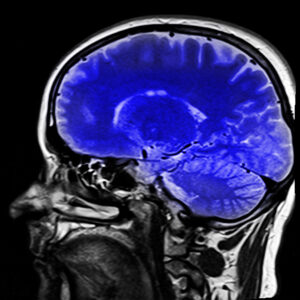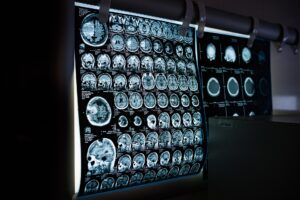Brain Damaged Killers
 Brain Damage That Creates a Mass Murderer
Brain Damage That Creates a Mass Murderer
Especially when we first hear a news story about an especially horrible set of murders we want that killer brought to justice. And any mention that brain damage might have caused the criminal’s behavior sounds like a flimsy excuse to get away with murder. This seems true because we’ve heard of people who’ve had strokes, or head injuries, or brain tumors, and none of them killed anyone. It is unusual. Criminal behavior occurs in less than ten percent of patients who’ve suffered a traumatic brain injury. So people with brain damage, even brain damage in just the specific correct brain circuits, don’t become crooks. But what about the people in that “less than ten percent”. That is, there are people who have brain damage that hits just the right place, that disrupts just the right brain nerve circuit, who then have a higher risk of committing criminal behavior.
Welcome to the Neuroscience Research and Development Consultancy website. If you would like more information about any of the topics we cover on our site, or if you have a question. a comment, or a critique, please send it to us at: Comment@NeuroSciRandD.com
One of our Readers in Stillwater, Oklahoma wrote to us with this comment:
There was a guy in the 1960s who shot a lot of people from a tower at UT Austin who they said had a brain tumor that made him do it. Is this true?
It’s partly true, though most people would not agree that his brain tumor made him kill people. His name was Charles Whitman. The events seem to be that he stabbed to death his mother and his wife, then went to the clock tower at the University of Texas at Austin and shot at people from the 28th floor observation deck. He shot 42 people, and 11 of them died. This reckless, killing behavior was especially odd because when he was teenager he had been an Eagle Scout in the Boy Scouts of America, then in his early 20s he was a decorated Marine in the U.S. military. It’s definitely true that at autopsy he was found to have a brain tumor.
On the one hand his brain tumor was said to be the size of a pecan nut. This might seem too small to cause a problem, but the size of the brain region it was pushing against was the size of an almond, that is, about the same size. This brain area is called the amygdala and it’s remarkably important in how a person behaves. It’s a major communication hub for emotions, and links emotions with memories, learning, and the senses. Charles Whitman’s brain tumor was pressing on his amygdala, his center for emotion and behavioral control. We at the Neuroscience Research and Development Consultancy don’t feel that the tumor made him kill people, but we do opine that it confused his thinking in a way that he really didn’t understand the implications of what he was doing when he took the lives of others.

The Unpredictable Nature of Disrupting a Complex System like the Brain
One cannot smash just the right spot in someone’s brain and turn them into a killer. Even a specific lesion can’t automatically be the only cause of criminal behavior. Many people with no known brain damage are outrageous crooks. But given the right set of other personal facts and then damage their brain and one can get an awful personality change. Genetic makeup and what they were like before the brain damage might be important. The cause of the damage and their age when it happened might also be factors. in addition, after the injury, the quality of their social support system and their social environment might change the final outcome. But whatever the specific mix that’s needed, it does happen. As one Scientific American article put it regarding Charles Whitman, what turns a twenty-five year old former Eagle Scout and decorated Marine into a deadly shooter?
It Can Be Either a Location or a Nerve Circuit
A study by Ryan Darby at Vanderbilt (reference below) is a remarkable piece of work in this area. He and his collaborators completed a mapping of lesion locations in twenty-three cases where new criminal behavior began after a brain-damaging event. They looked both at the location of the lesions and within what brain nerve circuits the lesions were. The research team identified seventeen people with a time-based link between the brain damage and the criminal behavior. Twelve of the seventeen cases involved violent crimes like assault, rape, and murder. The other five were “white collar” crimes like fraud and theft. In fifteen of the cases there was no criminal behavior before the brain damage, and two other cases the cimininal behavior went away after the damage was treated.
The Four Important Findings of Dr. Darby and His Research Group
In discussing their findings, Dr. Darby’s group laid out four specific important findings from their research.
- First, while it was true that the damaged areas in the brains that led to the criminal behavior were in different brain areas in different people, the lesions all sat within one brain nerve network. Brain damage in brain areas not in this network do not cause criminal behavior.
- Second, this network circuit where lesions cause criminal behavior connect to brain regions involved in moral decision making don’t connect to areas related to empathy or cognitive control.
- Third, lesions time-linked with criminal behavior show connectivity opposite the connectivity of brain regions activated by weighing moral choices. This predicts the bias toward criminal behavior seen in these patients.
- And finally, fourth, when they took what they learned and applied the evaluation process to a different set of people they got the same result. That is, their research was reproducible from one set of people to another.

The Case of Jordan Rice and her Frontal Lobe Meningioma
Though I’m a neuroscientist and psychiatrist, every time one of these cases hits the news I’m upset. Read our page “Your Mind & Your Brain” to understand why. Let me mention this one case. Jordan Rice is the mother of three and wife of Robert Rice, who’s in the U.S. Marines. Sometime in 2016 or 2017 a tumor, a cancer, began to grow in the covering of her brain right next to her brain’s frontal lobe. As it grew and began pressing on her brain she became apathetic, not caring about anything. And, no one was there to notice. On May 24, 2018, Mrs. Rice called 911. Her 13-month-old daughter had died. When the police came it appeared that the little girls died of neglect. She was emaciated, in an unchanged diaper, and weighed only ten pounds. Mrs. Rice was arrested. No one knew about the brain tumor.
Jordan Rice in Jail Had To Go Blind In Both Eyes for Someone to Notice
After eight months in jail she was complaining of crushing headaches and then went blind in both eyes. (She’s never regained her sight.) Finally an MRI was done and it showed a brain cancer the size of a baseball. She was rushed to surgery and the tumor was removed. It was a a type called a meningioma. Despite being brain damaged and having no way to function she was still held accountable for the “crime” of her daughter’s death. At the time when their 13-month-old daughter, Violet, died, Jordan’s husband Robert was working in Florida as a military contractor. Jordan’s attorney has made a motion to the court to dismiss the case. Her usual previous personality, bright, aware, active, and concerned, had slowly returned after the baseball-size cancer was removed from her brain.
 The Tumor and the Legal System Have Made a Mess of Everything
The Tumor and the Legal System Have Made a Mess of Everything
Jordon Rice’s two older children are in foster care. Both grandparents have been denied access to them since 2018. Jordon’s husband Robert maintained visits with his surviving children after his wife’s arrest. But after a year the prosecutors arrested him for “child abuse and reckless manslaughter”. He took a plea deal in the manslaughter case and is currently incarcerated in Baldwin County. And don’t forget, Jordon Rice is now permanently blind.
Jordon Rice Needed Medical Care When Her Personality Changed
As people look back and piece together what happened, they realize that there was a huge change in her personality and behavior during the months before her daughter Violet died. That’s when she needed an MRI and the surgery, when the tumor was growing and pressing on her brain’s frontal lobe. Ryan Darby, MD, whom we mentioned above, has said that tumors that grow near the front of the brain often cause the biggest changes in values and decision-making. Jordon is now totally blind, her two children are in foster care, her husband’s in jail, she had a baseball-size cancer removed from her brain, and the prosecuting attorneys still want to prosecute her. Good grief. It’s true that attorneys don’t go to medical school, but in this instance they seem stupid (or heartless) beyond that deficiency.
 Yes It’s Rare But When the Key Fits the Lock…
Yes It’s Rare But When the Key Fits the Lock…
We think we can imagine your complaints and disagreements bubbling up. But… But… But… It’s true that there are about 700,000 people living with brain tumors in the U.S. And the known and documented cases of brain tumors perhaps leading to criminal behavior are maybe a few dozen. So it’s not as though a brain cancer makes a person a criminal, and just having a brain tumor is not an automatic defense against criminal activity. As we point out on our page “Your Mind & Your Brain”. our brains are complicated! A tumor doesn’t automatically make a person a criminal. But a brain tumor that damages just the right brain nerve circuits can change a person so dramatically that their behavior can fall of the cliff. Bad behavior, bad brain.
Reference
Ryan Darbya, Andreas Hornb, Fiery Cushmang, Michael D. Fox. Lesion network localization of criminal behavior. Proceedings of the National Academy of Sciences, Vol. 115 No. 3, December 18, 2017, pp. 601 – 606. Edited by Kent A. Kiehl, The Mind Research Network, Albuquerque, NM, and accepted by Editorial Board Member Michael S. Gazzaniga November 20, 2017 (received for review April 25, 2017)
Helpful links:
Proceedings of the National Academy of Science on Lesion Network Localization of Criminal Behavior
Scientific American on Killers with Brain Damage
Amy Yurkanin. The brain tumor defense: Did an Alabama mother mean to kill her toddler? AL.com. September 20, 2021.

 Brain Damage That Creates a Mass Murderer
Brain Damage That Creates a Mass Murderer  The Tumor and the Legal System Have Made a Mess of Everything
The Tumor and the Legal System Have Made a Mess of Everything Yes It’s Rare But When the Key Fits the Lock…
Yes It’s Rare But When the Key Fits the Lock…